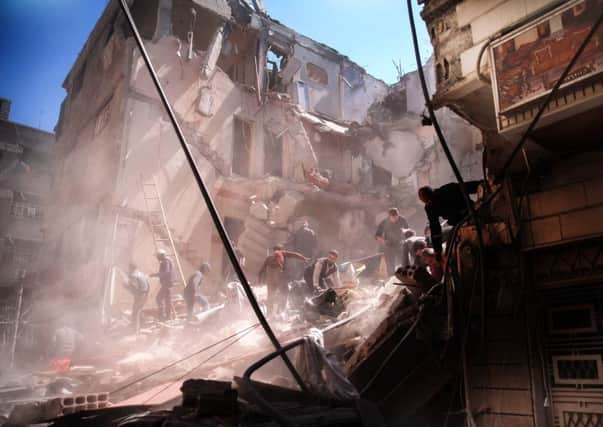Harrowing images of Syria '˜gas attack' spark calls for action


Eyewitnesses said the attack was carried out by jets operated by the Russian and Syrian governments, but both Moscow and Damascus denied responsibility.
Photos and video emerging from Khan Sheikhoun, which lies south of the city of Idlib, the provincial capital, showed limp bodies of children and adults.
Advertisement
Hide AdAdvertisement
Hide AdSome were seen struggling to breathe; others appear foaming at the mouth. The activist-run Assi Press published video of paramedics carrying victims from the scene by a pickup truck. The victims were stripped down to their underwear. Many appeared unresponsive.
The UK-based Syrian Observatory for Human Rights monitoring group put the death toll from the gas attack at 58, saying there were 11 children among the dead.
Meanwhile, the Idlib Media Centre said dozens of people had been killed.
The media centre published graphic footage of medical workers appearing to intubate an unresponsive man stripped down to his underwear and hooking up a little girl foaming at the mouth to a ventilator.
It was not immediately clear if all those killed died from suffocation or were struck by other airstrikes occurring in the area around the same time.
It was the third claim of a chemical attack in just over a week in Syria. The previous two were reported in Hama province, in an area not far from Khan Sheikhoun, the site of yesterday’s alleged attack.
Foreign Secretary Boris Johnson said attack “bears all the hallmarks” of the Syrian government. Johnson said in a statement that he was “horrified,” at the reports of the attack and said Bashar Assad’s government has repeatedly used chemical weapons in the past.
Meanwhile White House spokesman Sean Spicer told reporters that President Donald Trump was “extremely alarmed” by reports of the attack and said it was “reprehensible and cannot be ignored by the civilized world.”
Advertisement
Hide AdAdvertisement
Hide AdSpicer also laid blame on the “weakness and irresolution” of former President Barack Obama’s administration, saying that Obama “did nothing” in the wake of previous chemical attacks in Syria.
US Ambassador Nikki Haley, current chair of the United Nations Security Council, confirmed last night that an emergency meeting had been scheduled for this morning.
Opposition activists and a doctor in Idlib said this was the worst incident since the 2013 toxic gas attack on the Damascus suburb of Ghouta that killed hundreds of civilians. That attack, which a UN report said used sarin gas, was the worst in Syria’s civil war.
A statement by the Syrian government said it “categorically rejects” using any chemical or poisonous agents in Khan Sheikhoun and said it did not and will not use them in any place or any time in the past or future.
It held rebels responsible, saying they attacked their own territory in order to distract from their losses across the country. The Russian Defence Ministry also denied any involvement.Tarik Jasarevic, spokesman for the World Health Organization in Geneva, said that the agency is contacting health providers from Idlib to get more information about yesterday’s incident.
The Syrian American Medical Society, which supports hospitals in opposition-held territory, said it had sent a team of inspectors to Khan Sheikhoun and an investigation was underway.
A UN investigation determined the Syrian government has ordered at least three chlorine gas attacks.